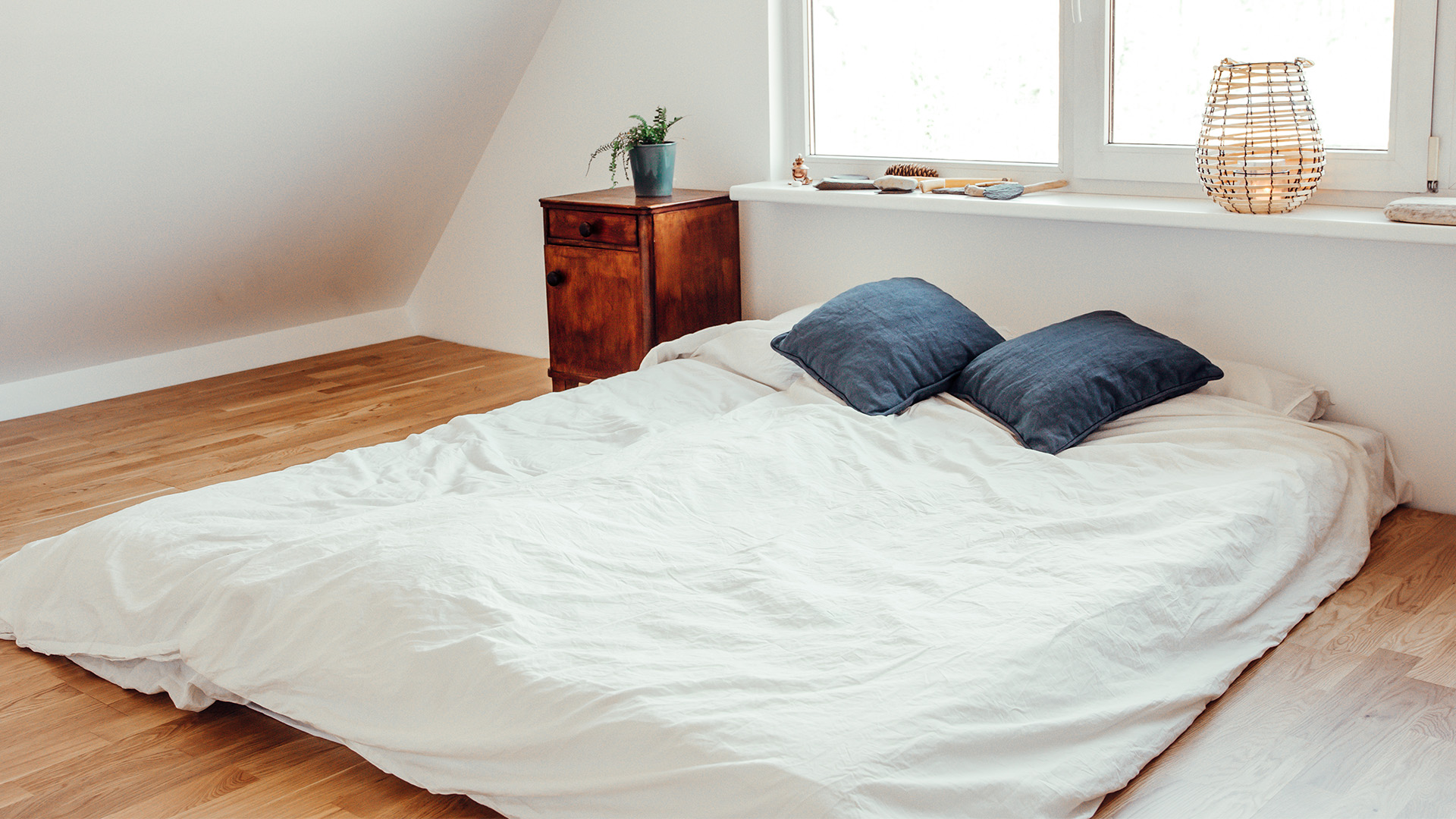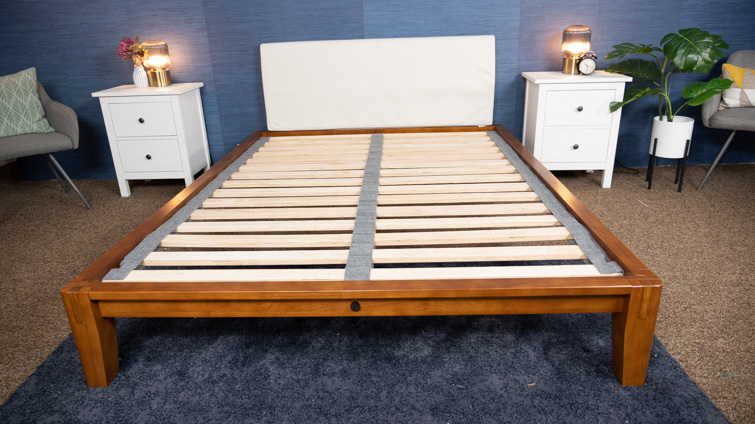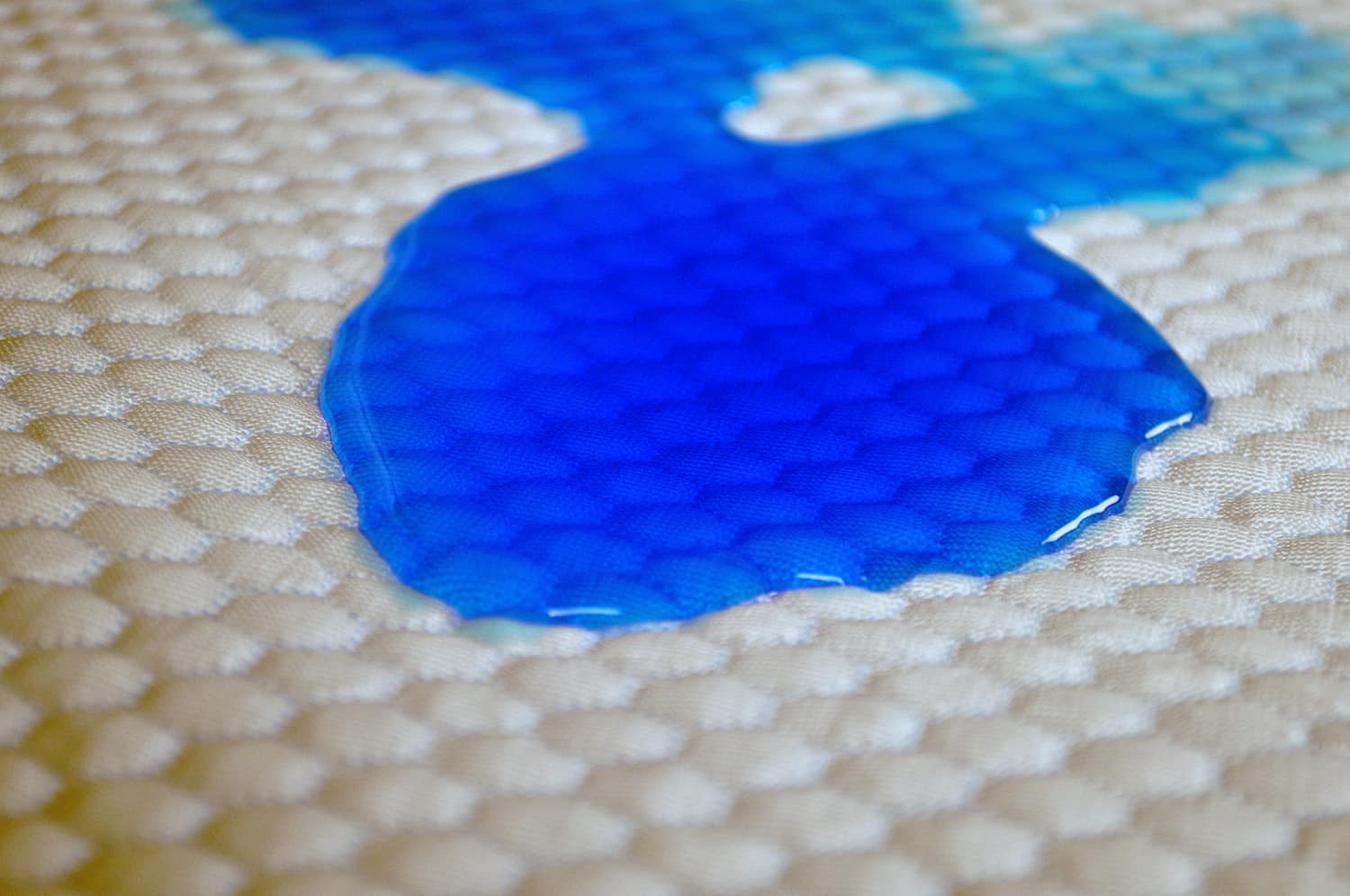
When you first buy your mattress, you’ll have to think about the type of foundation, box spring, or frame you want to go with it. But what if you want to forego the extra accessories and put your mattress on the floor? There are benefits and drawbacks to both using a foundation and laying your mattress on the floor. Some people prefer the minimalist look and firm feel of having a mattress on the floor. Be aware, however, that in some cases your warranty can be voided if you don’t lay your bed on a foundation specified by your mattress company.
Keep reading to learn about the pros and cons and whether putting a mattress on the floor could help you get your best night’s sleep .
Is It Bad to Put a Mattress on the Floor?
Putting your mattress on the floor can be either a great idea or a horrible idea — it completely depends on your unique sleep circumstances.
Pros of Putting a Mattress on the Floor
- Putting your mattress on the floor saves time and money shopping for a bed foundation. Bed frames and box springs can cost anywhere from hundreds to thousands of dollars, so keeping your bed on the floor can save up some room in your budget.
- If you suffer from back pain or bad circulation, putting your mattress on the floor could give you the extra support you need. Laying your mattress directly on the ground makes your mattress feel firmer and provide a more even level of support.
- Bulky bed frames and the furniture that goes with them can take up lots of space in your bedroom. Going without a bed foundation could give your room a trendy minimalist aesthetic and make your bedroom seem bigger.
- If you sleep hot, keeping the mattress on the floor might help cool you off. Hot air rises, and the air is cooler closer to your floor and air vents. Check out our roundups of the best cooling mattresses and cooling sheets for more great options for hot sleepers.
Cons of Putting a Mattress on the Floor
- Putting a mattress can void your warranty — which means you’re out of luck if your mattress turns out to have defects. Some mattresses need certain supports to prolong their lifespan and keep them in good condition. Check your warranty to ensure that you aren’t risking the investment in your bed if you keep your mattress on the floor.
- Sleeping on the floor means your mattress is in closer proximity to dust, dust mites, mildew, mold, bugs, and allergens. If you have allergies, it’s a good idea to keep your mattress lifted off the ground.
- For those with mobility issues, keeping the mattress on the floor could make it more difficult to get in and out of bed.
- If you have a foam bed or another mattress that tends to trap heat, you’ll want to elevate your mattress. When you lay your mattress directly on the ground, there is nowhere for the air to flow through and excess heat can linger in the mattress.

Tips for Putting a Mattress on the Floor
If you decide the pros outweigh the cons — and have double-checked your mattress warranty — you might want to try putting your mattress on the floor. We recommend doing the following if so:
Clean. Regularly clean your mattress and floor to reduce the risk of allergens affecting your sleep or contaminating your mattress.
Air it out. Allow your mattress to air out. When your mattress lays on the ground, it can store moisture near the base of the bed and cause mildew. Prop your mattress upright against a wall for a few hours every few months to allow it to dry out.
Avoid foam. If you want to sleep on the floor, steer clear of foam mattresses. Foam is prone to trapping heat and moisture, which can cause mold and mildew to grow in the bed. Foam mattresses also can become damaged if they aren’t laid on a foundation, which compromises the bed’s level of support and can make for an uncomfortable sleeping experience. Innerspring mattresses and hybrid mattresses are better options if you want to forego a foundation.
Be selective with the surface. Put your mattress on finished surfaces. A hardwood floor is easier to keep clean and won’t harbor dust mites and dirt like a carpeted floor.
Add insulation. Add a thin layer of insulation to the mattress. Creating a barrier of foam or cardboard between the mattress and the floor will help keep your mattress clean without compromising your firm level of support or minimalist look.
Protect the bed. Use a mattress protector. Wrapping your mattress in a protector can help your mattress stay clean and can also keep allergens like dust, bugs, and mildew at bay.

Types of Mattresses to be Put on the Floor
Some mattresses will work well placed on the floor — certain beds are even designed to be laid directly on the ground without a foundation. Most of these beds are under six inches tall and are designed for guests or to be tucked away during the day when they aren’t being used. Here are some examples of beds designed for floor placement:
- Folding mattress: Usually about four to six inches thick and made of high-density polyurethane or memory foam, folding mattresses fold up into thirds or fourths for easy storage. These beds are useful to have around for guests, especially children, and are designed to be laid out on the floor. Look for one that comes with an allergen-repellant or machine washable cover to make sure your foldable bed stays clean and comfy for your guests.
- Rolling mattress: Rolling mattresses are like futons that you can roll up and store in your closet when not in use. They are relatively thin, very compact, and easy to store. These mattresses are often made of foam and can also be used on camping trips.
- Air mattress: Air mattresses are beds that you can inflate with air to sleep on, then deflate, fold up, and tuck away after you wake up in the morning. Air mattresses are inexpensive and can last up to six years if you use them correctly. They aren’t designed for extended use, however, and will wear down faster if you use them frequently.
FAQs
Can a mattress be placed on the floor?
In some cases, your mattress can be placed on the floor to create a firm sleeping surface and a minimalist environment — but you should make sure putting a mattress on the floor won’t void your warranty before you decide to get rid of your foundation.
Does it damage a mattress to sleep on the floor?
Some mattresses need a specific type of foundation or support, and sleeping on the floor could damage the mattress or make it break down faster. Check with your mattress manufacturer to find out whether your mattress could be damaged by putting it on the floor.
Does a mattress need to breathe?
It is a good idea to let your mattress breathe to avoid trapping moisture in the bed, which can cause mold and mildew. If you sleep on the floor, you should air out your mattress occasionally to make sure it stays dry and clean.
Is it okay to put a box spring on the floor?
You can leave your box spring on the floor. If you do, make sure to keep your floor clean so your box spring isn’t contaminated with dirt or dust mites.
Is it better to sleep on the floor or mattress?
It is typically better to sleep on a mattress because a mattress provides a balance of support and comfort that can help keep your back in a healthy posture.
Conclusion
If you want to save money on extra furniture, prefer a firm sleeping surface, and like a minimalist feel in your bedroom, you may want to consider putting your mattress on the floor. Before you decide to sleep sans-foundation, make sure that sleeping on the floor won’t void your mattress warranty, wrap your mattress in a protective cover, and keep your floor clean to make sure you don’t compromise the quality of your bed.


























